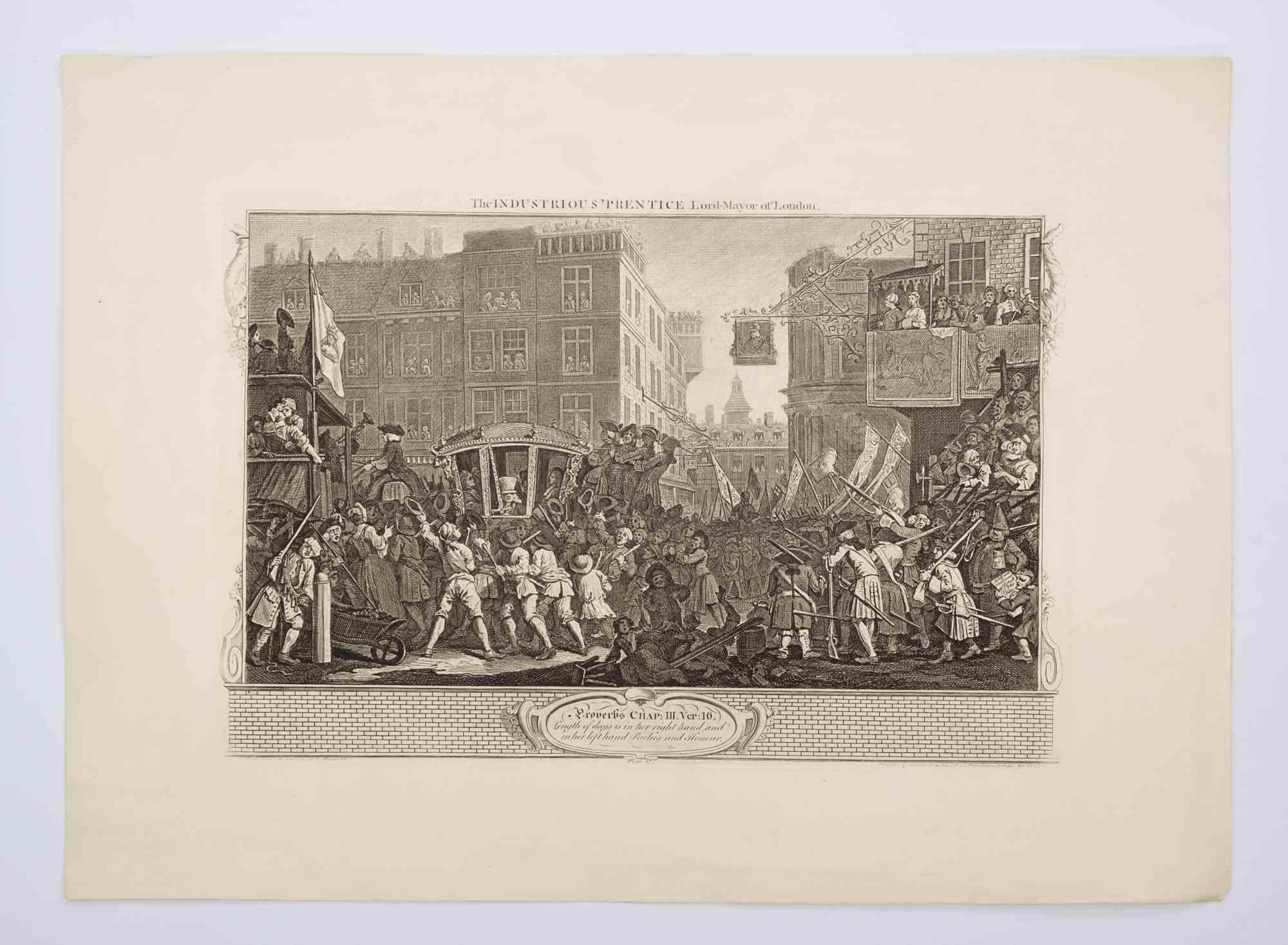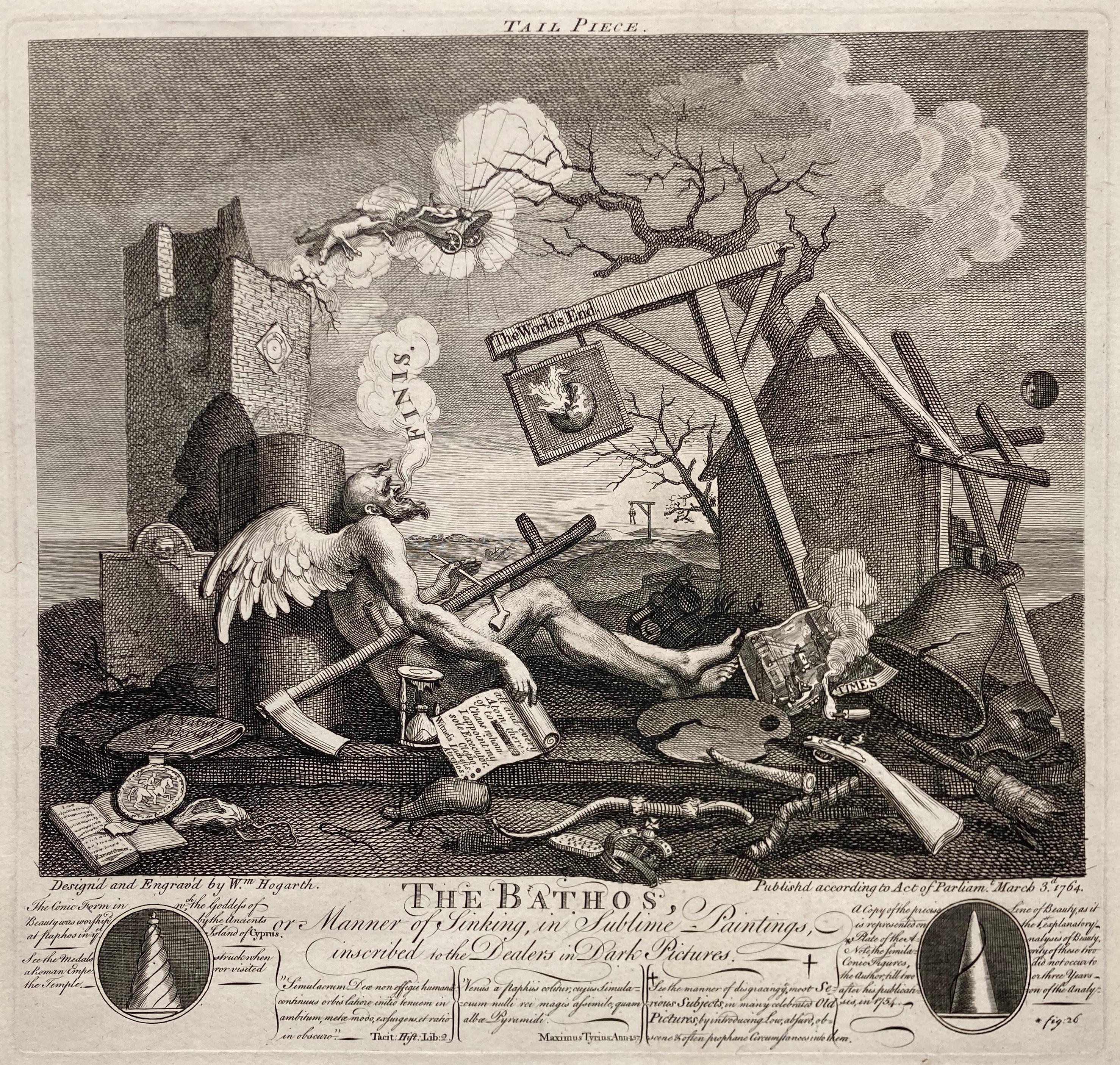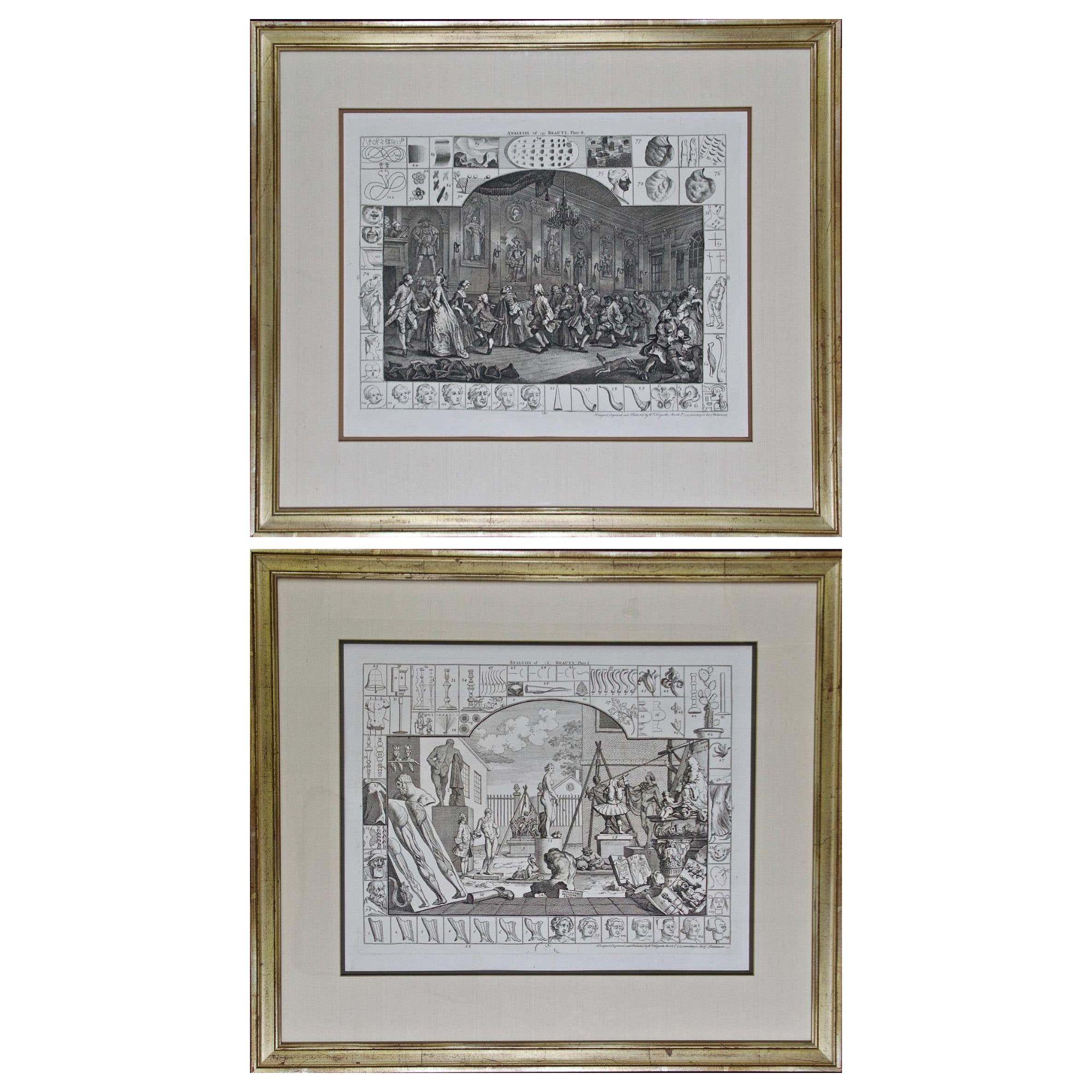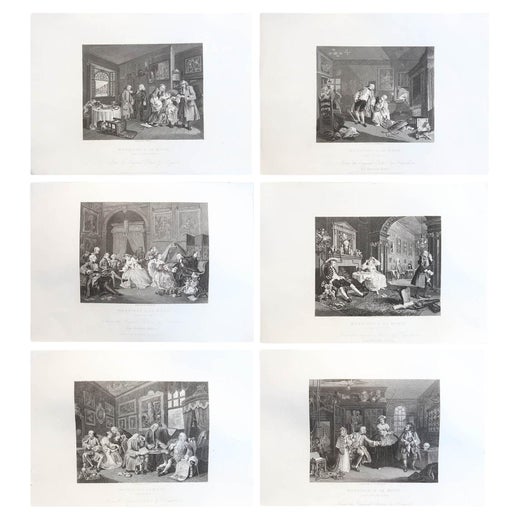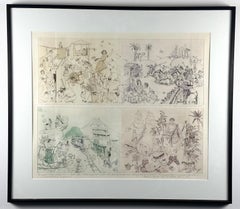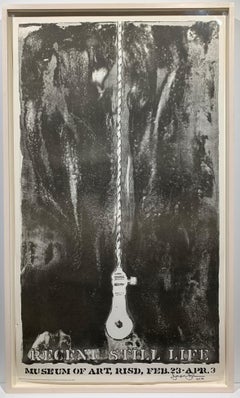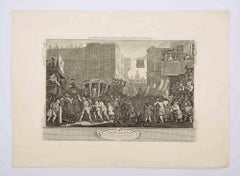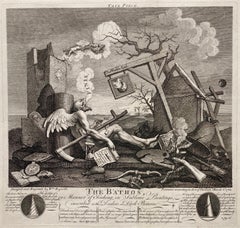Items Similar to Character vs. Charicature
Want more images or videos?
Request additional images or videos from the seller
1 of 12
William HogarthCharacter vs. Charicature1743
1743
$350
£271.60
€306.65
CA$500.82
A$546.48
CHF 282.73
MX$6,537.58
NOK 3,571.59
SEK 3,353.67
DKK 2,290.14
About the Item
William Hogarth (1697-1764).
Character vs. Charicature, 1743.
Engraving on laid paper, plate measuring 8.25 x 9.25 inches. Framed measurement: 16.25 x 20.25 inches.
Characters and Caricaturas is an engraving by English artist William Hogarth that he produced as the subscription ticket for his 1743 series of prints, Marriage à-la-mode, and which was eventually issued as a print in its own right. Critics had sometimes dismissed the exaggerated features of Hogarth's characters as caricature and, by way of an answer, he produced this picture filled with characterisations accompanied by a simple illustration of the difference between characterisation and caricature.
Picture
Hogarth's earlier pictures had come under fire from critics for portraying characters in an exaggerated fashion, by reflecting their morality directly in their features, clothes and surroundings. In his book on art, The Analysis of Beauty, Hogarth claimed that the critics had branded all his women as harlots and all his men as caricatures, and complained:
…the whole nest of Phizmongers were upon my back every one of whome has his friends and were all taught to run em down.[1]
To rectify what he saw as an egregious mistake on the part of his critics, and being "perpetually plagued, from the mistakes made among the illiterate, by the similitude in the sound of the words character and caricatura",[2] he designed the subscription ticket for Marriage à-la-mode to clearly illustrate their error. Untitled at the time of issue, it is now known as Characters and Caricaturas or just Characters Caricaturas. At the foot of the picture, Hogarth illustrated the difference between characterisation and caricature by reproducing three character figures from the works of Raphael, and four caricatures: Due Filosofi from Annibale Carracci; a head originally by Pier Leone Ghezzi, but here copied from Arthur Pond's Caricatures; and a Leonardo da Vinci grotesque reproduced from the French Têtes de Charactêres.[3] The images from Raphael are easy to identify as being from his Cartoons (even if they were not labelled Cartons Urbin Raphael Pinx below) but John Ireland commented that the originals' "grandeur, elevation and simplicity are totally evaporated" in Hogarth's rendering.[4] Hogarth also added a line drawing in the space above the second caricature to indicate the simplicity with which caricatures can be produced. Above this demonstration, he filled the remaining space with 100 profiles of "characters", which clearly shows his work has more in common with the work of Raphael than the caricatures produced by the other Italian artists. Hogarth later wrote that he was careful to vary the features of these heads at random to prevent any of the portraits from being identified as a real individual, but the sheer number of profiles inevitably meant this was not entirely successful, since "a general character will always bear some resemblance to a particular one".[2]
Though Hogarth claimed in the inscription to The Bench that "there are hardly any two things more different" than character and caricature, modern commentators suggest that his division of the category of comic portraiture, if not artificial, was at least innovative: Hogarth invented the categories merely to be able to place himself in a line of artistic succession that descended from Raphael and to distance himself from the caricaturists of his day—such as Arthur Pond—who, despite lacking artistic training, were tackling much the same subject matter that Hogarth was himself addressing.[5]
Below the picture, Hogarth added a rider: "For a further Explanation of the Difference Betwixt Character & Caricature See ye Preface to Joh. Andrews". Here he is referring to his friend Henry Fielding's 1742 work, Joseph Andrews, in which Fielding explains that a character portrait requires attention to detail and a degree of realism, while caricature allows for any degree of exaggeration. Fielding positions himself as a "Comic Writer" and Hogarth as a "Comic Painter", and dismisses the caricaturists as he dismisses the writers of burlesques.[6] Fielding wrote in defence of Hogarth in the preface:
He who should call the Ingenious Hogarth a Burlesque Painter, would, in my Opinion, do him very little Honour; for sure it is much easier, much less the Subject of Admiration, to paint a Man with a Nose, or any other Feature of a preposterous Size, or to expose him in some absurd or monstrous Attitude, than to express the Affections of Men on Canvas. It hath been thought a vast Commendation of a Painter, to say his Figures seem to breathe; but surely, it is a much greater and nobler Applause, that they appear to think.[7]
On the original subscription ticket, a further section detailed the forthcoming issue of Marriage à-la-mode with details of its content, price and issue date. A copy of the ticket finished with Hogarth's signature, a wax seal and an acknowledgement of receipt from a "Mr McMillan" is held by the British Library. In 1822, the print was re-issued in its own right, minus the subscription details, by William Heath.
- Creator:William Hogarth (1697 - 1764, British)
- Creation Year:1743
- Dimensions:Height: 20.25 in (51.44 cm)Width: 16.25 in (41.28 cm)Depth: 1 in (2.54 cm)
- Medium:
- Movement & Style:
- Period:
- Condition:
- Gallery Location:Wilton Manors, FL
- Reference Number:1stDibs: LU245217203612
William Hogarth
William Hogarth (1697-1764) was an English painter, printmaker, pictorial satirist, social critic, and editorial cartoonist. Hogarth's work was extremely diverse, ranging from serious realistic paintings and portraits to satire and moralistic pieces filled with symbolism. He often communicated his moral message in a series of paintings and engravings, such as: A Rake's Progress, Marriage A-la-Mode and A Harlot's Progress. He was by far the most significant English artist of his generation and inspired a movement of English caricaturists and satirists, including James Gillray (1756-1815), Thomas Rowlandson (1757-1827), Isaac Cruickshank (1764-1811) and George Cruickshank (1792-1878). His work has been studied intensely for the greater than two and a half centuries since his death with several academic scholars focusing their careers on the analysis of every element of each of his creations.
About the Seller
4.9
Platinum Seller
Premium sellers with a 4.7+ rating and 24-hour response times
Established in 2007
1stDibs seller since 2015
433 sales on 1stDibs
Typical response time: 4 hours
- ShippingRetrieving quote...Shipping from: Wilton Manors, FL
- Return Policy
More From This Seller
View AllIndian Without Reservations
Located in Wilton Manors, FL
Chris Orr (British, b. 1943)
Indian Without Reservations, 1968.
Artist's proof etching, composed of four scenes. Edition of 30 with 5 Artist's proof, of w...
Category
1960s Surrealist Figurative Prints
Materials
Etching
Black Broadway Street Dancers
Located in Wilton Manors, FL
Beautiful WPA era NYC street scene by American artist, Albert Sway (b.1913). Jiggers on Broadway, ca. 1935. Lithograph on paper, image measures 9 x 13 inches. Full sheet measuring 11...
Category
1930s American Realist Figurative Prints
Materials
Paper, Ink
Death of the Virgin (Old Master drawing)
Located in Wilton Manors, FL
Old Master drawing, Death of the Virgin Surrounded by Apostles, ca. 17th century.
Ink pen and wash on paper. Sheet measuring 11 x 15.5 inches. Framed measurement: 18.5 x 23.5 inches...
Category
17th Century Old Masters Figurative Drawings and Watercolors
Materials
Ink
Recent Still Life RISD exhibition poster
By Jasper Johns
Located in Wilton Manors, FL
Jasper Johns (b. 1930): Recent Still Life
Lithograph in black on wove paper, 1966, signed and dated '2016' in ink.
34 1/2 x 19 3/4 in. (sheet), 36 1/2 x 21 1/2 in. (frame).
Provenance:
Property from the Collection of Tom Levine...
Category
Mid-20th Century Abstract Abstract Prints
Materials
Paper, Lithograph
$4,800 Sale Price
20% Off
Pleasure Function (Black Surrealist Philadelphia artist)
By Roland Ayers
Located in Wilton Manors, FL
Roland Ayers (1932-2014).
Pleasure Function, 1972.
Ink on paper, 7 × 7 inches (image). Sheet measures an irregular 10 × 10 inches.
Signed and dated.
Acid-free matting measuring ...
Category
1970s Surrealist Abstract Drawings and Watercolors
Materials
Paper, Ink
Life Magazine Satirical Society Cartoon Illustration
Located in Wilton Manors, FL
Barbara Shermund (1899-1978). Society Satirical Cartoon, ca. 1940s. Gouache on heavy illustration paper, image measures 17 x 14 inches; 23 x 20 inches in matting. Signed lower left. Very good condition but matting panel should be replaced. Unframed.
Provenance: Ethel Maud Mott Herman, artist (1883-1984), West Orange NJ.
For two decades, she drew almost 600 cartoons for The New Yorker with female characters that commented on life with wit, intelligence and irony.
In the mid-1920s, Harold Ross, the founder of a new magazine called The New Yorker, was looking for cartoonists who could create sardonic, highbrow illustrations accompanied by witty captions that would function as social critiques.
He found that talent in Barbara Shermund.
For about two decades, until the 1940s, Shermund helped Ross and his first art editor, Rea Irvin, realize their vision by contributing almost 600 cartoons and sassy captions with a fresh, feminist voice.
Her cartoons commented on life with wit, intelligence and irony, using female characters who critiqued the patriarchy and celebrated speakeasies, cafes, spunky women and leisure. They spoke directly to flapper women of the era who defied convention with a new sense of political, social and economic independence.
“Shermund’s women spoke their minds about sex, marriage and society; smoked cigarettes and drank; and poked fun at everything in an era when it was not common to see young women doing so,” Caitlin A. McGurk wrote in 2020 for the Art Students League.
In one Shermund cartoon, published in The New Yorker in 1928, two forlorn women sit and chat on couches. “Yeah,” one says, “I guess the best thing to do is to just get married and forget about love.”
“While for many, the idea of a New Yorker cartoon conjures a highbrow, dry non sequitur — often more alienating than familiar — Shermund’s cartoons are the antithesis,” wrote McGurk, who is an associate curator and assistant professor at Ohio State University’s Billy Ireland Cartoon Library & Museum. “They are about human nature, relationships, youth and age.” (McGurk is writing a book about Shermund.
And yet by the 1940s and ’50s, as America’s postwar focus shifted to domestic life, Shermund’s feminist voice and cool critique of society fell out of vogue. Her last cartoon appeared in The New Yorker in 1944, and much of her life and career after that remains unclear. No major newspaper wrote about her death in 1978 — The New York Times was on strike then, along with The Daily News and The New York Post — and her ashes sat in a New Jersey funeral...
Category
1940s Realist Figurative Paintings
Materials
Gouache
You May Also Like
"The Beggars Opera" and " A Just View of The British Stage" Original Etchings
By William Hogarth
Located in Houston, TX
The original design for the top half was formally attributed to William Hogarth, according to the Met Museum, and published by John Bowles in 1728. The edition here has a second half...
Category
1820s Baroque Figurative Prints
Materials
Etching
William Hogarth . Original engravings 155 pсs., 1 piece with blend. 1822 London
By William Hogarth
Located in Riga, LV
William Hogarth (1697-1764)
Original engravings 155 pсs., 1 piece with blend. 1822 London
From A. Neibergs collection
Category
1820s Realist Figurative Prints
Materials
Paper, Engraving
The Industrious Prentice - Etching by William Hogarth - 1747
By William Hogarth
Located in Roma, IT
The Industrious Prentice - Lord Mayor of London is an original etching print realized by William Hogarth in 1747
Signature on the plate on the lower right, with the description on t...
Category
1740s Old Masters Figurative Prints
Materials
Etching
BATHOS / Tail PIece
By William Hogarth
Located in Santa Monica, CA
WILLIAM HOGRATH (1767- 1764)
THE BATHOS / Tail Piece 1764 (Paulson 1989: 216 I/I Paulson 1965/70: 216 I/I)
Engraving Plate 12 7/8 x 13 3/8, sheet 17 ¾ x 18 ¾ Designed & Engrav’d by Wm Hogarth at left and Published according to Act of Parliam’t March 3, 1764 at right. Good condition on thick laid paper Small bit of tape on the left & right sheet edges small stan lower sheet edge all on recto.
This Hogarth’s last print is fascinating as it is prophacy about death.
Various institutions have interesting commentaries - to wit:
Chicago Art Institute: Hogarth created The Bathos toward the end of his life. It is considered one of the bleakest artworks of the 18th century because it depicts the Apocalypse without an afterlife. The Angel of Death even collapses in exhaustion after having destroyed the world. In his hand is an execution decree and around him lies a mass of broken objects.
Princeton: Hogarth’s last print, The Bathos,….. is filled with all manner of images denoting the end of life as we know it. Entry no. 216 in Ronald Paulson’s catalogue raisonne Hogarth’s Graphic Works, 3rd revised edition says “This print is the culmination of such pessimistic images . . . . [taking] his general composition, the configuration of objects, and some of the particular items, from Dürer’s engraving, Melancholia; but he also recalls Salvator Rosa’s Democritus in Meditation (which derives from Dürer’s print) with a scroll at the bottom of the etching: ‘Democritus the mocker of all things, confounded by the ending of All Things’ (Antal, p.168).”
Newfields (Indianapolis Museum of Art): Hogarth intended this engraving to serve as the tailpiece to bound volumes of his collected engravings and, appropriately, it proved to be his last engraving. Father Time has died and his last will and testament has been witnessed by the three Fates. He is surrounded by a landscape of death, decay, and ruin. Hogarth aimed this print at dealers in “dark” Old Masters paintings who promoted the idea that ruins evoked sublime feelings in viewers—a sentiment, Hogarth wrote, that was reducing the world to ruin.
British Caricature...
Category
1760s Old Masters Figurative Prints
Materials
Woodcut
William Hogarth's "Analysis of Beauty": A Set of Two Framed 18th C. Engravings
By William Hogarth
Located in Alamo, CA
The two plates in this set were created utilizing both engraving and etching techniques by William Hogarth in 1753, originally as illustrations of his book on aesthetics, entitled "Analysis of Beauty". Due to their popularity, these plates were later published separately. The publication line in the lower right reads: "Designed, Engraved, and Publish'd by Wm. Hogarth, March 5th 1753, according to Act of Parliament." Hogarth's original copper plates were refurbished where needed by James Heath and engravings were republished in London in 1822 by Braddock, Cradock & Joy. This was the last time Hogarth's copper plates were used for printing. Most were melted during World War I for the construction of bombs.
These large folio sized "Analysis of Beauty" engravings are presented in antiqued gold-colored frames with double mats; the outer silk mats are light brown-colored and the inner mats are dark brown. Each frame measures 27.38" x 31.25" x 1.13". There is one tiny spot in the right margin of plate 1 and another in the lower margin; the latter could be from the printing process. The prints are otherwise in excellent condition.
The "Analysis of Beauty" series is in the collection of many major museums, including: The British Museum, The Metropolitan Museum of Art, The Tate Museum, The Chicago Art Institute and The Fine Arts Museums of San Francisco.
The first engraving (Plate 1) depicts a courtyard of statues which is filled with some of the most famous works of classical sculpture. The most important sculptures are surrounded by less impressive works. The Medicean Venus (#13) is in the center with a statue of Julius Caesar (#19) to the right, elevated on a pulley with a short, overdressed Brutus stands over the falling Caesar. The Apollo Belvedere (#12) is next. A judge stands to the right with his foot on a cherub (#16). Another crying cherub holds a gallows and wipes his tears with the judge's robe.
A sphinx (#21) and the drunken Silenus (#107) are below the Venus. Michaelangelo's torso (#54) and a statue of Antonius (#6) are seen in the foreground. The Farnese Hercules (#3) and a bust of another Hercules (#4) under two statuettes of Isis are also included in the scene.
The key to these objects is included in the form of a serpentine line winding around a cone (#26), Hogarth's "Line of Beauty". For Hogarth the winding line is an essential element of beauty in art. Hogarth's theory of beauty is communicated in this plate.
Plate 2 is thought to represent the Wanstead Assembly, with the Earl of Tynley and his household. It is an adaptation of a scene in the Happy Marriage series, which complements Hogarth's Marriage à la Mode...
Category
Mid-18th Century Old Masters Interior Prints
Materials
Engraving, Etching
"A Harlot's Progress" Plate 3 Etching
By William Hogarth
Located in Houston, TX
Etching from the series titled "A Harlots Progress" by William Hogarth. The series consists of six paintings and engravings. The story is about a woman named M. Hackabout who arrived in London and started working as a prostitute. The third plate is of her getting arrest for her choice in profession. The series is a satirical story that emphasizes the dangers of being a prostitute and the health risks that come from it.
In 18th century engraving, the detail of the black mole on women and men's face is a symbol of the deadly venereal disease, syphilis. In this plate, Hackabout has already contracted the disease and that is why the black dot is visible on her forehead as well as her madam's.
In 1828, William Innell Clement published Harlot's Progress in columns on a single page of his newspaper Bell's Life in London #330. The detail with the cross seen in earlier reproductions of the engraving.
Dimensions without Frame: H 14.5 in x W 16.5 in.
Artist Biography: William Hogarth ( 10 November 1697 – 26 October 1764) was an English painter, printmaker, pictorial satirist, social critic, and editorial cartoonist. His work ranged from realistic portraiture to comic strip-like series of pictures called "modern moral subjects", perhaps best known to be his moral series A Harlot's Progress, A Rake's Progress and Marriage A...
Category
1730s Old Masters Figurative Prints
Materials
Etching
